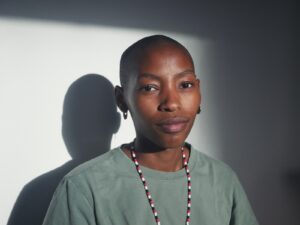“Where do we go from here?” On the haunting whispers of Afro-surrealism
19/10/2024 13:00 - 18:00 Mjellby Art Museum, Halmstad
Please join us for the public programme, “Where do we go from here?” On the haunting whispers of Afro-surrealism with Cecilia Germain, Naima Nefertari, and Mmabatho Thobejane, curated by Tawanda Appiah. This event accompanies the exhibition Dreams and Visions by the Sea, which features works by Ingela Ihrman and Muhammad Ali.
Using Afro-surrealism as a site of the mythical, the uncanny, and the ancestral, this programme embraces the movement’s subversion and disobedience as vital modes of resistance. Afro-surrealism, in all its richness, confronts the absurdities hurled at Black life through symbolism, spirituality, and radical imagination. It is a site where dissonance meets beauty, and where the past and present converge in ways that are both unsettling and transformative.
The afternoon begins with a live reading of Afrosurreal Manifesto: Black Is the New black—a 21st-Century Manifesto by D. Scot Miller, delivered by Tawanda Appiah and Mmabatho Thobejane. This sets the stage for Cecilia Germain’s unveiling of her site-specific botanical installation, which intricately weaves together a selection of African and European flora. Attendees are invited to participate in the performative ceremony by drinking a specially blended tea, a subtle communal gesture symbolising the shared experience of ingesting the art and what it carries.
Following this, the programme presents a screening of Ousmane Sembène’s (1923–2007) seminal film Black Girl (1966), a monochromatic masterpiece that remains a haunting meditation on dislocation and alienation, offering a reverse gaze on colonial narratives. The screening will be followed by an artist talk, inviting panelists to reflect on and engage more deeply with the themes, as they unpack their individual and collective practices and explore how Afro-surrealism informs and resonates within their work.
The day will culminate in a listening session by Naima Nefertari exploring processes of collaging and abstracting sound, as a method of composition and as a live process. Drawing inspiration from nature, history, and the everyday, Nefertari creates fragmented soundscapes, layering textures and recordings to meditate on the concept of “Organic Music” proposed independently by two major influences on the artist: the composer Julius Eastman (1940-90), and her grandfather, the jazz musician Don Cherry (1936-95).
Bus to Mjellby
A free bus departs from Halmstad station to Mjellby art museum at 12:15 and returns to the station at 18:00. Limited number of seats. Book by sending an email to lars.friden@regionhalland.se
The bus departs in connection with the Öresund train from Gothenburg that arrives in Halmstad at 12.03 and the Öresund train from Malmö which arrives in Halmstad at 11.46.
——————-
In conjunction with the exhibition Dreams and Visions by the Sea at Mjellby Art Museum and different locations in Halmstad, Art Inside Out has invited additional artists and curators to a participate in series of programs exploring the legacy and underlying ideas of surrealism. In artist presentations, performances and participatory works, the artists form dialogues with Mjellby Art Museum in ways that allow for clashes as well as new perspectives and encounters to emerge.
Photo: Ousmane Sembène, Black Girl, film still, 1966
Particpants
![]()
Tawanda Appiah is a Zimbabwean curator, writer and researcher based in Malmö, Sweden. His research-centred practice often revisits history to make sense of the contemporary milieu.
He is the curator at Skånes konstförening, alongside his independent practice, and previously held the position of Curator of Education & Public Programming at the National Gallery of Zimbabwe. Appiah has curated several exhibitions, public programmes and interventions including FLIGHT (Malmö Konsthall, 2023) which featured works by Kudzanai Chiurai, Frida Orupabo and Eric Magassa.
He was part of the 2024 jury for the Liljevalchs konsthall vårsalong. Appiah sits on various boards including Paletten Art Journal.
Photo: Ikram Abdulkadir
![]()
Cecilia Germain is a Swedish-Canadian artist living in Uppsala since 2018. After her studies at the Department of Art at Konstfack in Stockholm, 2000-2006, Germain has worked on themes that deal with colonial structures, historiography, memory work, grief, pathways to healing and decolonisation, Black public health and social justice.
Painting, photography, text and performance are recurring mediums of her expression, but the artist also works with botanical materials and with botany as a growing archive, a way into stories, health, knowledge, history and hope for the future. Working with plants becomes the artists Afrofuturistic practice, something she wants to share with you.

Naima Nefertari (aka Karlsson) is an interdisciplinary artist, musician and composer based in London and Sweden. Her practice interweaves sonic and visual forms led by interests in repetition, improvisation, and relationships between language, image, symbol and sound.
Naima’s main instrument is the piano, as well as percussion, vibraphone, and organ. Improvisation is at the core of the artist’s musical process, combined with minimalist uses of tone and an inherently organic approach to playing – calling on concepts of “Organic Music” proposed independently by two major influences on the artist: the composer Julius Eastman (1940-90), and her grandfather jazz musician Don Cherry (1936-95).
Naima is an archivist and coordinator for the Estate of Moki Cherry and Cherry Archives. She is also part of the duo Exotic Sin with Japanese multi-instrumentalist Kenichi Iwasa and has a monthly show on NTS Radio.
Photo: Anders Sune Berg

Mmabatho Thobejane (she/they) is a South African cultural worker and sangoma based in Stockholm, Sweden. At the moment she spends most of her time as a producer at MDT – Moderna Dansteatern. She is a conduit to ancestors who, through pono ya moya, an African Traditional Health practice, provide spiritual guidance to those who seek their services. Further, through workshops like altar sessions, they employ the altar as a gathering site where participants are invited into and practice deeper relations with themselves, each other and the earth.
As a curator who is a sangoma, Mmabatho creates spaces that can connect us with ancient wisdom and guidance that rumbles quietly but consistently, waiting to be noticed and aligned with.
Photo: MyNa Do
/https%3A%2F%2Fartinsideout.se%2Fwp-content%2Fuploads%2F2024%2F01%2F28849id_026_original.jpg)